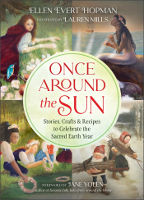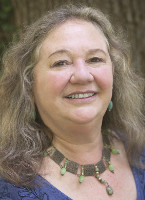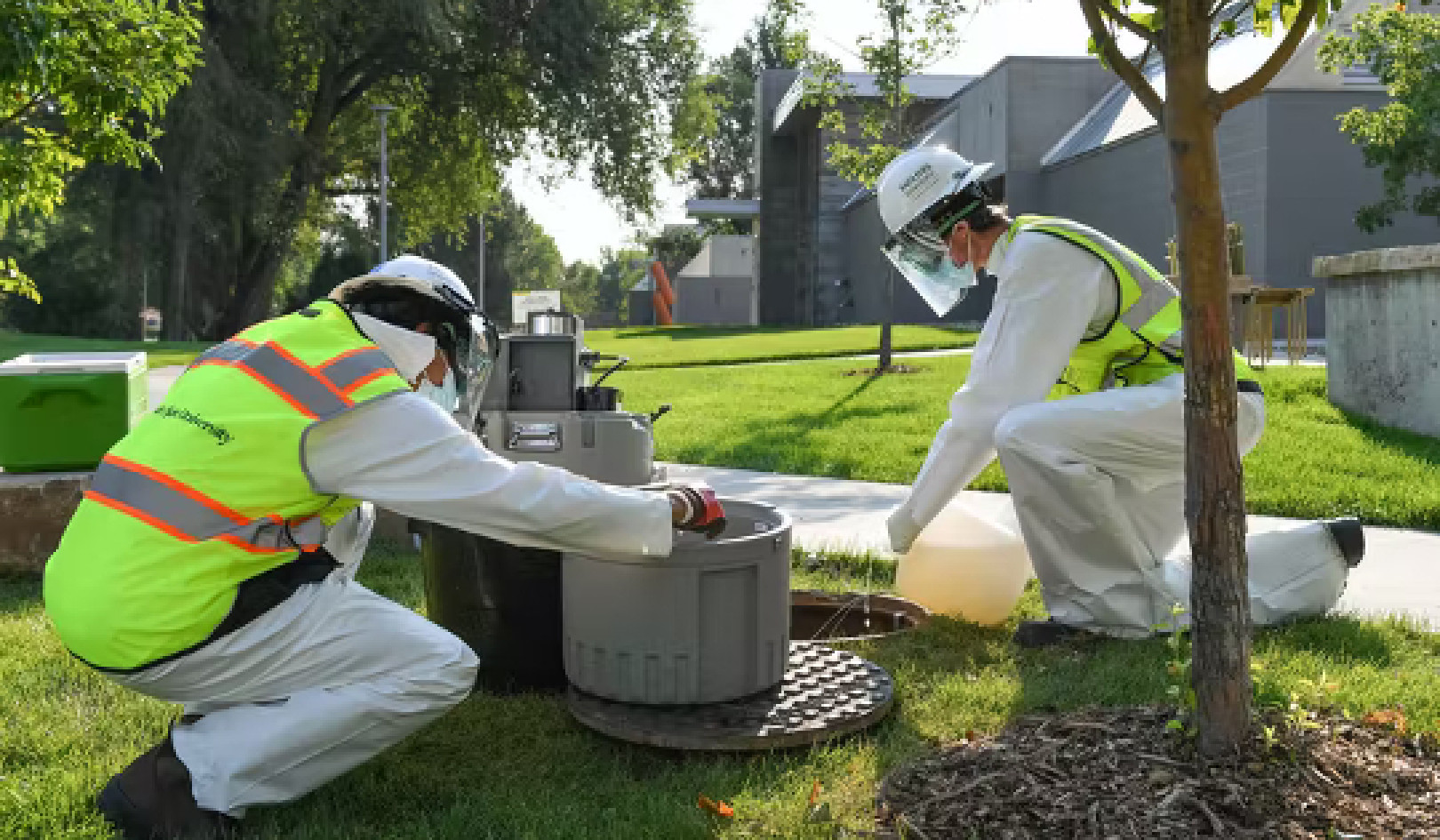
“The Cailleach Bhuer” by ~AltaraTheDark
For the ancient Celts, there were only two seasons of the year: winter and summer. Winter began at Samhain* (October 31–November 1), and summer began at Beltaine*. In those days, when homes were lit only by candles and people traveled on foot or by horse, wintertime could be dark and dreary. So, after dinner, the family would wash and dry the dishes and then sit down before the hearth to hear a story.
Sometimes storytellers called shanachies would visit from house to house and, in exchange for a meal, offer a tale or two. In this way, the long, cold nights were made warm and cozy as the elders passed their history and traditions down to the children, just as the geese teach their young to fly south each year.
The old shanachie* had been visiting the snug little thatched cottage where Fiona lived since before she was born. On Samhain Eve, he appeared as usual to tell the story of the Cailleach*, the great Goddess of Winter, whom some called the Bone Mother or the Great Hag, for on that very night her reign was beginning and the whole family was gathered to learn and remember.
After they’d eaten and the family had gathered in front of the fire, the shanachie began his tale.
“Tonight, the world is turning from the season of meadowlarks and bees, of apples and grain and flowers, to the quiet days of frost and snow,” he said. He was looking Fiona in the eye, because she was the youngest member of the family and he wanted to make sure she took in every word
. “Now begins the time of cold, darkness, and death. Your father, brothers, and uncles have gathered the flocks and bolted them into their snug pen. Your mother, aunts, and sisters have ground the sausages, salted the meat, and hidden the apples in their straw-lined pit. The grain is safely stored, dry and clean in sacks in the barn. Outside the wind is singing a song of coming storms. The Great Hag of Winter is on the move!”
The shanachie paused for effect, taking a slow drink from a cup of herbal tea that Fiona’s grandmother had thoughtfully placed beside his chair.
“How does the Goddess travel?” Fiona asked.
The shanachie replied, “She travels on the back of a wolf. That is why many people call Eanáir*, the coldest month of the year, the Wolf Month.” “Is she the one that makes the ice and snow?” asked Fiona.
“Oh yes, that is one of her greatest powers,” said the shanachie, smiling.
“However does she do that?” asked Fiona. Her eyes were as wide and round as the Moon in the sky.
“Well,” said the shanachie, “in the west of Scotland, in the ocean, is the giant whirlpool of Corryvreckan. That place is the Cailleach’s washtub. Every year at Samhain she scrubs her plaids in that whirlpool, and they come out as white as frost. After that, the land is covered in snow because, you see, her plaids are the land itself.”
“But doesn’t she do her washing at any other time?” asked Fiona, because it seemed strange to do laundry only once a year.
“Oh yes, indeed,” said the shanachie. “When the whirlpool is filled with foam, that means she is treading her laundry by trampling it with her feet. And if you hear a loud clap of thunder, that means she is sneezing!”
That remark provoked giggles from the whole family.
The shanachie continued, “You see, the Ancient Veiled One is so tall that she can easily wade across lakes and rivers, and she likes to leap from hilltop to hilltop. She carries a wicker basket filled with stones on her back, and wherever she drops a stone, an island or a mountain forms. She also carries a slaitín draíochta* made of aspen wood to blast away any small scrap of green that dares to poke up its head in the dark season. And wherever she touches the ground with her wand, the soil instantly freezes as hard as stone!”
Fiona shivered and snuggled deeper into her mother’s lap.
“Her reign ends at Beltaine, when she hides her slaitín draíochta in a spiky thicket of holly or a bristly tangle of gorse. She picks it up when the year turns to winter once again.”
“But what does she do all summer?” asked Fiona. “Six months is an awfully long time to wait, with nothing to do.”
“Oh, she is still busy,” replied the shanachie. “The Ancient One has plenty of work all year. You see, she likes to roam the countryside with her cows and goats and lead them to the beach to eat seaweed. As she is the Goddess of the Land, she loves all animals. She is also the guardian of the deer and makes sure they stay happy and healthy.”
“Even though they can’t see her,” he continued, “she whispers thoughts into the hunter’s ears, advising them how many deer to shoot and at which times. Good hunters show her every respect because she reminds them to always honor the balance of nature. The best hunters will always bless the animals they have taken to feed their family, because they know that if they forget to do that, the meat will belong to the Faeries. And they will always remember to whisper thanks to the Goddess for her generous bounty.”
Fiona had never seen a Faery, though she could sometimes hear them singing when she sat very still in the forest.
“How do the Faeries get the meat if the hunter forgets to bless it?” she asked.
“Ah, a good question, and here’s a tale to remember,” the shanachie replied. “One time some boys went out and shot a deer. They were very excited and proud of themselves, imagining all the praise they would get when they returned to their village. They completely forgot to bless the meat or to thank the deer that had given its life. All they did was tie a rope around the deer’s legs and begin to drag it home.”
“When they got back to their village, even though they had felt the heavy weight of the deer the whole way through the forest, all they had was an empty rope dragging behind them. The deer had disappeared! You see, the Faeries took it, to teach them a lesson.”
“How can there be only an empty rope if they still felt the weight of the deer?” Fiona asked, crossing her arms and shaking her head in disbelief. The shanachie smiled, taking another sip of the excellent herbal tea.
“Ah, sure, you haven’t yet come across Faery magic, but your grandmother has. It’s in this tea that surely the Faeries have blessed.”
Fiona’s grandmother smiled with a nod, and the shanachie continued.
“Now, the Cailleach is a woman of magic and mystery, too. Sometimes she appears as a seagull. She may also appear as an eagle, a heron, or a cormorant. When she and her helpers ride on the backs of wolves or wild pigs, they are often followed by herds of deer or wild boar.”
“In the season of summer, she sometimes shape-shifts into a large stone,” he told her, holding his hands out wide to show her just how big. “You will know which one because it is always wet, even in the driest season. At Imbolg*, she gathers firewood to last her until Beltaine. If the weather is good and she can collect a great store of wood to warm the house, that means there is still a long winter ahead. But if the weather is drizzly and cloudy and she is forced to stay inside, that means the winter is nearly over.”
“The Ancient Veiled One can bless or curse the tribes, depending on whether they honor her properly,” he continued. “We should always remember to thank her because she is the one who taught the people how to thresh the grain, using a flail made of holly wood with a striker made of hazel. She also taught us to thresh on a clean floor, to sow oats in late winter, and to harvest the green grain before the late summer storms set in.” (A flail is a threshing tool made of a wooden staff with a short heavy stick swinging from it.)
“Does she ever come to our farm?” Fiona asked. “How will I know if she has been here?”
“Well,” said the shanachie, “if you have ever seen a pile of stones or a solitary boulder at the top of a mountain, that is a spot that is sacred to her. It is proper to leave a gift of oat cakes or butter at such a place. There are stones like that nearby; I am sure you have seen them while you were out picking berries. A solitary stone standing in the landscape can be a sign of her presence, too. That is often a person or animal she turned to stone because they didn’t show her the proper respect.”
Fiona gulped.
“Mountain springs are her special sanctuaries, and she drinks from them to renew her powers. If you find a hidden forest spring, you should walk around it nine times and then drink from its waters. Be sure to leave an offering of thanks, too; a bit of cheese or bread and some cider or honey are nice. But if you don’t have those with you, you can always offer a prayer or a song.”
“And now,” he said, getting up from his seat by the fire, “you know all about the Cailleach, the ancient Bone Mother and sacred Goddess of the Land. I hope you will show her every honor in the coming season of snow and ice.”
And with that, he put on his warm cloak, winked at Fiona, and disappeared out the door into the windy, wild weather.
* * * * *
Irish/Gaelic Words to Know:
*Beltaine (BELL-tayn)—the Celtic May Day festival, when herds of animals (like cows and sheep) were ritually blessed by having them pass them between two great fires on their way up to their summer pasture in the hills. The traditional Irish spelling is Bealtaine (be-OWL-tin-eh).
*Cailleach (KAHL-yuk)—a Goddess of the land and in some areas the Goddess of Winter
*Eanáir (AHN-oar)—January.
*Imbolg (IH-molg)—a Celtic festival held on February 1–2 celebrating the lactation of ewes, who give birth at about this time, and the Goddess Brighid. A medieval name for the festival is Oimelc, “ewe’s milk.”
*Samhain (SOH-win)—a holiday, celebrated from October 31 to November 1, marking the date by which all produce from the fields had to be safely harvested and stored, because anything left out after that time belonged to the Faeries. In modern times, we call this celebration Halloween.
*shanachie (SHAH-na-key)—a traditional teller of tales; sometimes spelled seanchaí.
*slaitín draíochta (SLAY-tin DRAY-och-ta)—a magic wand
© 2022 Ellen Evert Hopman.
Edited excerpt printed with permission
from the publisher, Destiny Books,
an imprint of Inner Traditions International.
Article Source:
BOOK: Once Around the Sun
Once Around the Sun: Stories, Crafts, and Recipes to Celebrate the Sacred Earth Year
by Ellen Evert Hopman. Illustrated by Lauren Mills. In this beautifully illustrated book, Ellen Evert Hopman shares rich stories drawn from traditional folktales, hands-on crafts, and seasonal recipes to help families and classrooms learn about and celebrate traditional holy days and festivals of the sacred earth year. Designed to be read out loud, the stories are complemented with pronunciation guides and translations for foreign words.
In this beautifully illustrated book, Ellen Evert Hopman shares rich stories drawn from traditional folktales, hands-on crafts, and seasonal recipes to help families and classrooms learn about and celebrate traditional holy days and festivals of the sacred earth year. Designed to be read out loud, the stories are complemented with pronunciation guides and translations for foreign words.
For each story, the author includes hands-on projects special to the holiday--from crafting magical wands and brooms to flower crowns and Brighid’s Crosses--as well as seasonal recipes, allowing families to enjoy the tastes, smells, and sounds associated with the feast days and celebrations.
For more info and/or to order this book, click here. Also available as a Kindle edition
About the Author
 Ellen Evert Hopman has been a Druidic initiate since 1984. She is a founding member of the Order of the White Oak, an Archdruidess of the Tribe of the Oak, and a member of the Grey Council of Mages and Sages. She is the author of several books, including Walking the World in Wonder.
Ellen Evert Hopman has been a Druidic initiate since 1984. She is a founding member of the Order of the White Oak, an Archdruidess of the Tribe of the Oak, and a member of the Grey Council of Mages and Sages. She is the author of several books, including Walking the World in Wonder.
The book's illustrator, Lauren Mills, has won national acclaim as both an author/illustrator and a sculptor. She is the author and illustrator of the award-winning The Rag Coat.




























